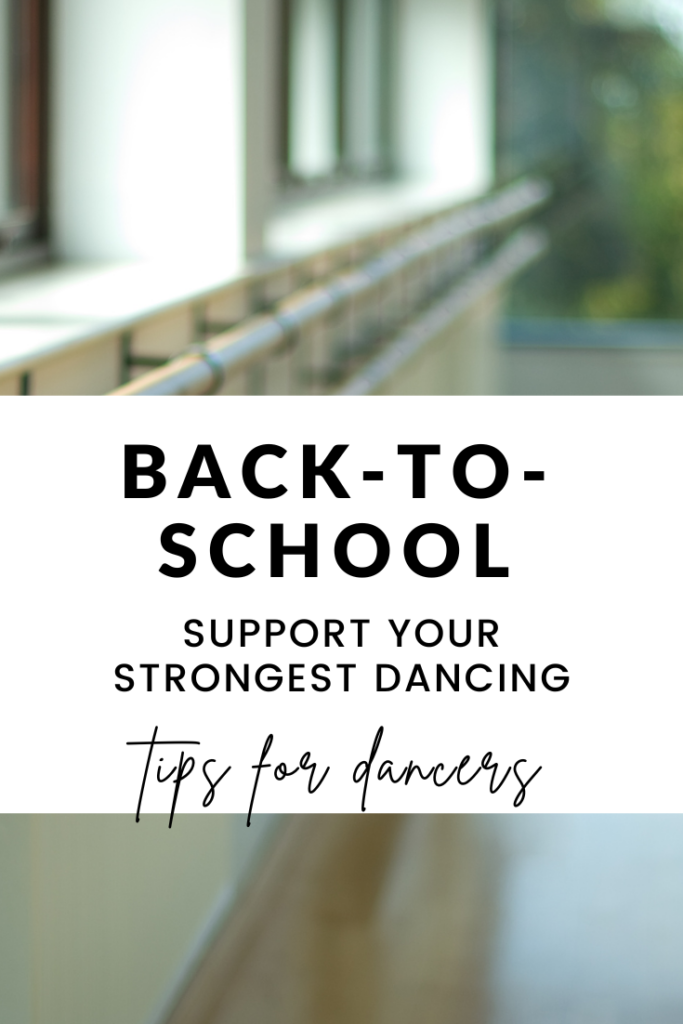Back-to-school is approaching and dancers are gearing up to dive back into their rigorous schedules— a balance of dance and academic coursework is the norm. For dancers returning home from summer intensives, fatigue, and injury might be the reality.
As a dietitian for dancers, August is one of my busiest seasons. A spike in stress fractures is to blame, along with the commonality of dancers feeling depleted from the struggle of eating adequately during their summer intensives.
Nutrition considerations for dancers heading back to school:
#1: Plan ahead
It’s simple: adapting to a new schedule can leave you forgetting to eat. And if that new schedule is extra busy, you’ll risk an overall diminishment of physical hunger cues. Planning a few meals and snacks for your week will help. Utilize these practical meal prep tips and consider the benefits of proactive fueling to support baseline nourishment even on your busiest of days.
#2: Snack with purpose
A running theme I notice among dancers during the school year is not having time for a full lunch. If you’re skipping that midday meal, you’re likely to experience a major energy crash come 3 PM. Building snacks that combine complex carbohydrates with foods rich in proteins and fats will help. These snacks not only replenish muscle glycogen (AKA energy for your dancing) but also, bridge the gap between your meals. Opt for snacks that combine protein and fiber, like yogurt with granola, nuts (or seeds), and fruit. Packable options are another route if commuting from school to dance. Here are 10 personal favorite snack recipes I shared with Pointe Magazine to get you started.
#3: Reevaluate your relationship with food
As you adjust to your new school year, consider the potential for shifts in your relationship with food. Summer intensives are often a culprit in picking up food rules. Reflect upon whether you’re avoiding specific foods or entire food groups. “Clean” eating behaviors perpetuate all-or-nothing thinking and while they might feel supportive of your performance efforts, can open doors to disordered eating.
#4: Embrace nutrition, but don’t obsess
Dancers need a wide range of nutrients to support performance. Getting in an abundance and variety of nutrient-dense foods like leafy greens, colorful vegetables, fruits, bread and bread products, dairy (and dairy-free alternatives), whole grains, and legumes (like beans and lentils) provide vitamins, minerals, and antioxidants that support immune function and bone health. But don’t forget: patterns over time matter more than a single food. Adding these options when accessible is helpful, but not the end-all-be-all to a supportive back-to-school meal plan.
#5: Get support
Transitions are never easy, especially for dancers who thrive in the comfort of their routines. Working alongside a licensed practitioner like a Registered Dietitian Nutritionist can offer concrete tools in supporting your back-to-school efforts. In my work with dancers, The Healthy Dancer® offers manageable support that fits into your busy schedule. And if Nutcracker auditions are coming up in early September, gaining clarity into a supportive eating routine will help.
10 Back-to-School Essentials for Dancers
For busy dancers, having the right tools and essentials can make all the difference in maintaining a balanced and successful academic and dance life. From a recent poll of my Instagram followers, here are 10 must-haves to ensure a smooth transition back to school.
- Dance Bag Organizer with compartments for shoes, water bottles, snacks, notebooks, and dance attire. A structured bag keeps your essentials in place and saves you time when you’re rushing between classes.
- Portable Snacks like granola bars, trail mix, nuts, and fruit to keep you fueled and focused during long school and dance days.
- Reusable snack bags to pack those bulk items while reducing your carbon footprint.
- Hydration is non-negotiable. Invest in a reusable water bottle to pack alongside you.
- Resistance bands and stretching tools like a mini foam roller and/or tennis ball alleviate soreness and improve blood circulation.
- A planner or digital calendar (shared calendars can ease the coordination of carpools to and from dance).
- Noise-canceling headphones are extra helpful when needing a quiet space to concentrate on school assignments while at the studio. They’re a game-changer in creating a focused environment.
- A homemade self-care kit equipped with essentials like lip balm, hand cream, facial mist, extra hair accessories, and a small mirror.
- A phone charger in case rehearsals last longer than expected.
- The Healthy Dancer® Survival Guide for on-the-go nutrition guidance. This edition is specific to your upcoming winter performance prep.



